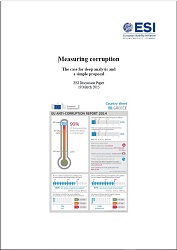MEASURING CORRUPTION. The case for deep analysis and a simple proposal
MEASURING CORRUPTION. The case for deep analysis and a simple proposal
Author(s): Author Not Specified
Subject(s): Public Administration, Transformation Period (1990 - 2010), Business Ethics, Corruption - Transparency - Anti-Corruption
Published by: ESI – European Stability Initiative
Keywords: EU soft power; anti-corruption; EU supervision;
Summary/Abstract: In its annual progress reports the European Commission offers descriptions of the institutional and legal infrastructure that play a role in combatting corruption in the seven accession countries. Such analysis matters: flawed laws, under-resourced institutions and ill equipped officials will obviously generate problems. But studying and improving the institutional and legal infrastructure is not an end in itself: its ultimate purpose is to change behavior. Even the best anti-corruption agency and even the most eloquent anti-corruption action plan are only the means to an end, not the end itself. || This raises the question of assessment of impact. Can the actual incidence of corruption in different walks of social life be fairly established? Can the impact of anti-corruption reforms be captured, measured, and the outcomes compared? || ESI believes that the European Commission has a powerful tool at its disposal to do just this. It is, however, a tool that is not currently used in the context of accession.
Series: ESI Discussion Papers
- Page Count: 13
- Publication Year: 2015
- Language: English
- Content File-PDF

